Wool is mainly composed of protein. Human use of wool can be traced back to the Neolithic Age and spread from Central Asia to the Mediterranean and other parts of the world, becoming the main textile raw material in Asia and Europe. Wool fibers are soft and elastic and can be used to make woolen cloth, yarn, blankets, felt, and other textiles. Wool products are characterized by a full hand feel, good warmth, and comfortable wearing. Sheep wool accounts for a considerable proportion of textile raw materials. The world’s major sheep wool producers include Australia, New Zealand, Argentina, China, and other countries. Sheep wool is divided into five categories: fine wool, semi-fine wool, long wool, hybrid wool, and coarse wool according to fineness and length. Chinese sheep wool varieties include Mongolian wool, Tibetan wool, and Kazakh wool.
Wool itself is a material that is easy to curl, soft, and tightly interlocked, forming a cluster that can produce thermal insulation. Generally, wool is white. Although it can be dyed, there are also individual types of wool that are naturally black, brown, and so on. Wool has water absorption and can absorb water equivalent to one-third of its weight, so wool itself is not easy to burn and has a fireproof effect. Wool is anti-static, which is because wool is an organic substance with moisture inside. Therefore, the medical community generally believes that wool is not irritating to the skin.
Characteristics of wool
Moisture absorption: Wool is a natural fiber with good moisture absorption. Studies have shown that regardless of the temperature and humidity conditions, its moisture absorption is superior to conventional synthetic fibers and natural fibers such as cotton and silk.
Coolness: When the human body sweats, wool’s high moisture absorption can maintain the humidity of the surrounding air within a lower range, which is one of the reasons why woolen fabrics are comfortable and dry in summer.
High water absorption: Wool is a very hydrophilic fiber, making it very comfortable to wear.
Warmth retention: Due to its natural curling, wool can form many non-flowing air intervals as a barrier.
Durability: Wool has excellent stretch and elastic recovery, and has a special wool scale structure and excellent bending properties, so it also has good appearance retention.
How to evaluate the quality of wool
The main factors for assessing wool quality are fineness, curl, luster, strength, and the cleanliness of the material.
Fineness is an important technological characteristic for determining the quality and value of wool fibers, expressed in micrometers or quality numbers. The finer the wool, the higher the quality number, and the finer the yarn spun.
Wool with neat and consistent curl shape produces soft, elastic, and warm yarn and products. Fine wool has more curls and higher density, while coarse wool has wavy or flat curls. The tensile strength has a direct impact on the firmness of the finished product. Length includes natural length and extended length. The former refers to the straight-line distance between the ends of the wool bundle, and the latter is the length obtained by stretching the fiber.
Luster is often related to the covering state of the fiber’s surface scales. Fine wool has weak reflectivity to light, and the gloss is relatively soft; coarse wool has strong and shiny gloss. Dim gloss is often due to damage to the scale layer.
Strength refers to the stress of wool fiber to break, and elongation refers to the length increase due to the action of breaking force. Different types of wool have significant differences in breaking strength. The fineness of the same type of wool is proportional to its strength. The more the wool is, the stronger its strength is. The better-developed the medulla of the wool with medulla, the poorer its resistance to breakage. Elasticity can maintain the original shape of the product and is an essential feature of wool used in carpets and blankets. Wool felting and moisture absorption are generally good.
The cleanliness of the material in wool refers to the amount of foreign matter, such as grass, leaves, and other vegetable matter, that is present in the material. It can affect the quality of the final product.
Care for woolen textiles:
Anti-pilling finishing processes
Woolen socks are molded products, and it is somewhat difficult to prevent pilling by burning or trimming the wool. Currently, the commonly used anti-pilling finishing processes are mild shrinking and resin finishing (which will be explained in detail in our upcoming article). Resin finishing has better results.

Anti-shrinking treatment
Scales are a major characteristic of wool fibers, which give wool its tendency to shrink. Therefore, the essence of anti-shrinking treatment is to process the scales to weaken or eliminate their directional frictional effect. This is mainly achieved by using chemical agents to interact with the scales, damaging and softening them; or by using resin to form a uniform film on the fiber surface. This effectively restricts the scales’ action and makes wool fibers lose their shrinkage, achieving the goal of anti-shrinking.
Anti-moth treatment
Woolen garments are often subject to moth damage during storage. Preventing moth survival on the fabric achieves the goal of anti-moth treatment. The auxiliaries used in anti-moth treatment should be efficient, low-toxicity, have no side effects on the human body, not affect the fabric’s color and color fastness, not damage the wool fiber’s feel and strength, and have characteristics of washability, sun resistance, and durability. Common anti-moth treatment methods include wool chemical modification and mothproof finishing.





